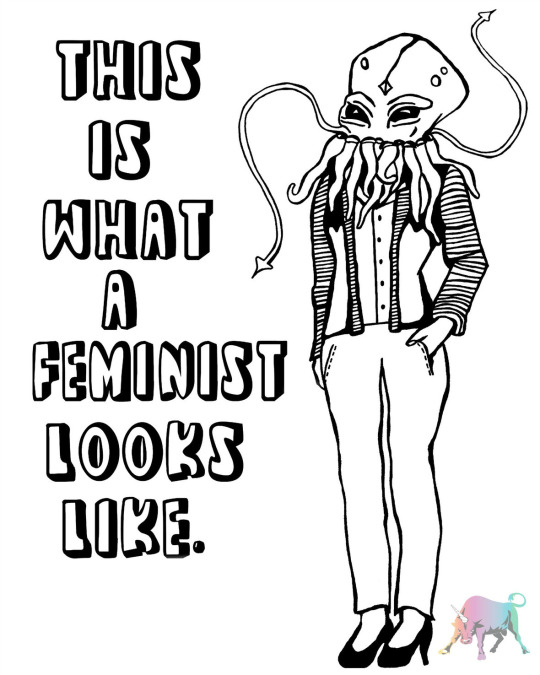hello, you can call me T. this blog is part my own art and part posts of and related to socially engaged art.
Don't wanna be here? Send us removal request.
Text
OMG after looking at nothing but shitposts and erotica for a few years i think i might be able to re-join the living and creating. things forthcoming??maybe??
5 notes
·
View notes
Text
Well this looks super useful. For the future.
47 Hacks People With ADD/ADHD Use To Stay On Track
1. “Take a picture of your to-do list otherwise #1 on your to-do list will be find the to-do list!” - Paris Swenson, Facebook
2. “Break long tasks into manageable segments. For example, you don’t have to ‘Clean your room,’ you have to: 1. Place all laundry in a basket… 2. Clear off desk…. 3. Organize your bookshelf… 4. Vacuum rug… Etc.” - alicegateso
3. “I keep a pad of paper by my keyboard at work. When I have a persistent thought that’s not associated with what I’m doing (I.E. ‘Call the plumber,’ ‘What kind of tree is that outside?,’ ‘I should wear more red.’) I write it down and promise myself I’ll think about it later. This let’s me acknowledge the thought and move on without falling down the rabbit hole.” - Lauren Dodson, Facebook
4. “I keep Word documents on each day and list what I got done so I can go back if I forget/lose track.” - Molly Jane Sisson, Facebook
5. “Have one place for every item that you use every single time. My keys, for example, always always always go on a hook beside the door.” - Chloe Burns, Facebook
6. “If you’re in school, you must invest in a planner. I leave nothing to my memory because if I’m not 100% paying attention during class, I will forget any assignment immediately.” - Chloe Burns, Facebook
7. “Try to block out sensory distractions when you’re doing a task that requires focus. I pick a quiet spot away from windows and monitors when I need to hunker down. Earplugs are helpful, and so is white noise” - snarkastik
8. “I make time each night/week to straighten up my living space. If all of my chores are done and the majority of my apartment is put together, I can think so much more clearly and can focus on more important things.” - zoeo429a8c39d
9. “Those giant desk calendars are great. I like to keep one on my wall and color-code classes/projects.” - Brooke Elise Henry, Facebook
10. “I keep a planner in my bag so that I can jot things down there, then transfer it all to my wall calendar at the end of the day.” - Brooke Elise Henry, Facebook
11. “I put my car keys underneath anything I need to remember to take with me. That way, I can’t physically leave without seeing the item I need.” - Amanda Egert Lee, Facebook
12. “I leave sticky notes on my keys.” - Amanda Egert Lee, Facebook
13. “I have to make it a point to remove all forms of communication from my reach so I know I’m only concentrating on the task at hand.” - andreaquido
14. “When I have a limited amount of time to do something (e.g. getting ready for work), I have a kitchen timer that I have go off every 3 minutes. It doesn’t seem like a lot of time, but you can get a lot done. When the timer seems to be going off too quickly and starts to become annoying, that usually means I’m daydreaming or focusing on the wrong thing.” - pantherkatz
15. “I like to get some time outdoors every day because it helps me find peace. After all, they say ADD brains are the brains of hunters! That’s why they’re always looking all over the place.” - llama7777777
16. “COLOUR CODE EVERYTHING. Bright colours in class notes, on important items, on tupperware lids, whatever. Bright colours are attention-grabbing and seeing ‘purple’ is faster than reading ‘Monday dinner leftovers.’ - Calico Jack Rackham, Facebook
17. “I like to go to productive places if I need to get work done; like the library, coffee shop, or studying with friends. When everyone around me is focused and working, it makes it easier for me to do so as well.” - gabbyh4940993bf
18. “I write notes with a dry erase marker on all of my bathroom mirrors.Things seem to hit me while I’m brushing my teeth or doing my makeup.” - Kristin Hasty, Facebook
19. “I have a 6×9 notebook that I keep with me because I’m constantly writing ‘to-do’ lists.” - Kristin Hasty, Facebook
20. “For remembering to take things with me as I leave, everything has to be by the door so I can’t leave without seeing it. Bonus points if my keys are in the pile.” - Sydney Anderson, Facebook
21. “I always convince myself I have to be somewhere earlier than I do. That way I have a few minutes buffer. If I have to be there at 8:30, I tell myself over and over that I have to be there by 8:15. It helps to have the clock in my car set 6 minutes fast. Even when I’m ‘running late’, I arrive a few minutes earlier than I actually have to be there.” - Cassie Costilow, Facebook
22. “If you have to read something with a due date, separate 10-15 pages with post its and set a time to read it through the day. Let’s say you have to read 90 pages for tomorrow, read 15 pages at 10 am, 12 pm, 2 pm, 4 pm, 6 pm and 8pm.” - stefr2
23. “When cleaning I try to focus on one small task at a time instead of the big picture. Instead of thinking ‘I’m going to reorganize the entire kitchen”, I think “I’m going to reorganize this cabinet.’ It really helps keep me from getting overwhelmed and shutting down completely.” - Cassie Costilow, Facebook 24. “I make it a point to have all my bills (except rent ) due on the same day. This way when the 15th comes, I write down a checklist of what needs to be paid, go through the list, and pay them.” - ltriebl
25. “I used to give myself deadlines for papers in undergrad. If something was not done by 2 a.m. I was not allowed to keep working on it. If the next morning was the deadline, too bad. By my 2nd year I never had to stay up all night, and by the time I got my M.A. it was completely internalized.” - Javiera Reyes, Facebook
26. “I use a massive white board calendar and color code things; blue for my sorority, green for due dates, red for tests, and black for other random events” -mckenziec45e41be03
27. “I schedule one day for cleaning. Everything gets done on that day even if it takes me hours.” - ltriebl
28. “My supervisor and I write a daily to-do list every single day. Instead of asking me to do things, she just writes it on my list. I cross out things as I accomplish them.” - Cierra Kemppainen, Facebook
29. “I always feel my pockets to make sure I have my phone, wallet, and keys before I leave a building or room. This has saved me more times than I ever thought.” - Adam Gottlieb, Facebook
30. “I carry my meds in my school backpack all the time. It’s great if I sit down in my first class and all of a sudden realize I didn’t take them.” - Adam Gottlieb, Facebook
31. “Because my motivation is so low with ADHD, my therapist told me the best thing to do to get things done is do them right when you think about them or else you’ll never do it. It may be obvious but it’s actually really helpful when there are important things to do.” - amandaz42502c3e2
32. “I write everything, EVERYTHING, down. When it comes to things people ask me to do, I write them down. Before we leave our meeting, I repeat all of their requests back to them. When they agree with each, I check it off. Once I complete the tasks, I cross them out twice. It’s tedious, but it definitely works.” - Adrienne Brooke, Facebook
33. “I tend to lean on people I know I can trust to help me remember things. I can rely on them without worrying about judgement.” - whitneyb19
34. “Crossing things off has become a sort of reward. When I notice I’ve crossed off more than three things at once I give myself a Buzzfeed break!Or Facebook, or Gchat. Just something to help blow off a little steam before I dive into the next task. It’s the best feeling seeing a list of 47 things all crossed off at the end of a stressful workday.” - Colleen Daniel, Facebook
35. “I always make lists in threes. Anything more than that and I end up losing focus of what I’m supposed to be doing, or hyper focusing and can’t switch tasks.” - keilande
36. “I also find that I’m more interested in keeping my personal life organized if it looks pretty, so at home it’s fun to do DIY projects that will actually create a more organized environment.” - Colleen Daniel, Facebook
37. “Laundry is a passive chore, so I’ll wash dishes while the machine is running. Two for one!” - bryanpb
38. “Break down your tasks! If you have a paper due in three days don’t just try to write the whole thing in one day, make a goal to finish a part of it each day.” - Brontë Ratcliffe, Facebook
39. “Try to only focus on one task at a time. It’s really tempting (REALLY REALLY TEMPTING) to do millions of unimportant things before you get to the one thing thats actually important. Think of your activities as if they are all contained in little boxes. Only open one box at a time and make sure that it is fully shut before you open the next box.” - Amy Langiano, Facebook
40. “Take lots of notes. In meetings I take diligent, detailed notes. I almost never refer back to them because somehow, just writing out the thought helps it stick in my mind, but the notes are there if I do need them later.” - gabriellao47ba20033
41. “Writing things down with a pen or pencil instead of typing them in computer and phone strengthens my memory of them.” - bobc409eb4106
42. “When I get ready for work in the morning, I set the alarm on my phone to go off every 10 minutes to help with time management. I have no concept of time if I don’t.” - Mallori Kraemer, Facebook
43. “I write up schedules even if I don’t use them perfectly. Just writing it down makes it stick better.” - katerg
44. “Prioritize what needs to be done by writing it all out and writing how long you estimate each task will take. That really helps me order things in a way that works for me.” - gabrielleca
45. “I make schedules for myself delineating how much time I anticipate each activity will take. Then, I build in 15-20 minute buffers on each to allow for the anticipated distractions and a couple of breaks. Works like a charm!” -emilyf4c854bde4
46. “I’m an introvert. So I tell friends and family to inform me of plans and events as early as possible. I need time to plan out my activities as well as make sure I have the mental energy to engage with others.” - pantherkatz
47. “Sit on an exercise ball while working on homework. It helps you by giving you something small to fill up your need for distraction while doing more tedious tasks.” - olivial7
6K notes
·
View notes
Text
Hmmmmm. Haven't read but yes. Feeling the same about the Walking Dead recently.
Do you ever get rly pissed because the hunger games films could’ve told such a deep story with themes that reflect our own society’s oppressive systems
but instead they whitewashed the main leads, erased their disabilities, and pretty much romanticized the violence
216K notes
·
View notes
Text
Noted.
sup. i have learned some stuff that u may find informative:
not eating/ avoiding animal products is fun, healthy, great 4 enviro and opens many culinary doors! but please remember if u are a herbivore (aka ‘vegan,’ although i personally avoid that term because it can be associated w a culture of shaming which i think discourages people from making the leap) to take calcium supplements with vitamin D/ magnesium (required to absorb the calcium) or eat foods that provide calcium (sesame seeds, spinach – google can tell u). i have mad calcium deficiency because i was a fool for like 15 years and never consulted a dietician or doctor or whatever. its v important to read up and not be a fool
so, important: you stop absorbing calcium when ur about 26 - 30. !!!!
consequences of calcium deficiency = taking gross giant pills every single day for the rest of ur life or face osteoporosis.
sorry for the spam haha.
xo
G
2K notes
·
View notes
Link
wouldn’t that be a cool visit? :)
0 notes
Link
Lidérc, the first story on this page, is about a demonic lover. Sensual and haunting. By Andrea Dezso, one and only!
0 notes
Text
After a brief hiatus...
I am posting again! My last posts on here are from when I passed my Div 3 project, December 10th- almost 2 months ago. On one hand it seems like it happened to so long ago, it can’t be only 2 months. But on the other hand I wonder - where did those 2 months go? What did I do? Well, about 2 weeks after officially passing, I moved into my new home in NYC and before I could get settled left on a trip across the ocean. First, my partner and I visited our good friend in Bangalore, India for a wedding. Then, while my partner returned to the states I traveled on to Perm, Russia, my birthplace where I had not been in over 2 years (there’s a lot of 2s in this paragraph...). This trip was filled with both new and exciting experiences as well as old, comforting ones. It challenged me to be present, which was sometimes easy and sometimes painfully difficult. I was productive with origami while in Russia, making the shapes I could - boxes, cranes, hearts, lilies, bunnies - out of candy wrappers. In the end I glued them into a garland and hung it over my babushka’s (grandma’s) mirror. She is an unconditional lover of my art. So now I am back from vacation, back on the internet, back to searching for a job, cleaning my house, cooking my food, etc. And I am in a new home, NYC, for no particular time limit. Just, to live. As I am searching for jobs I am also searching for friends, for community, for special places, for a space for my art, for “success” and for Happiness. That is a lot to do at once. I keep needing to remind myself not to compare my life to the lives of others. That takes up a lot of energy, and that energy is better used on reaching my own goals and manifesting my own desires. My life and art continue to be intertwined. Here’s to evolving in the process! ~*~*~
0 notes
Photo
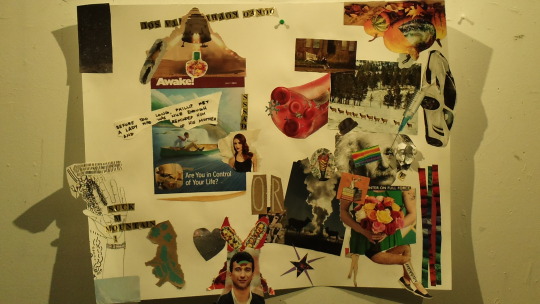
Almost forgot - communal collage from show night!
0 notes
Photo

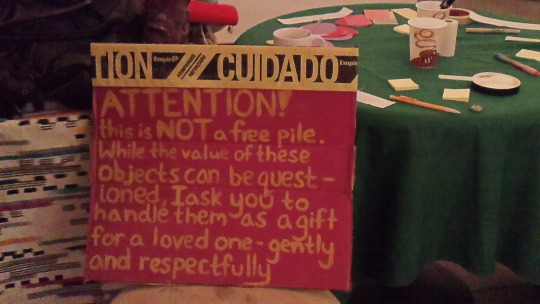
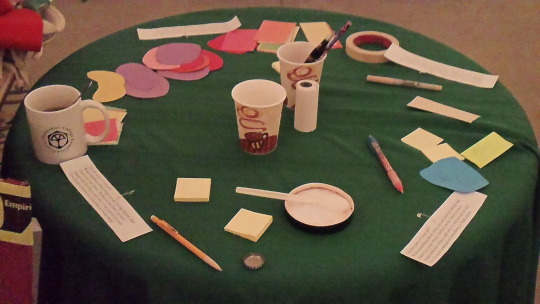
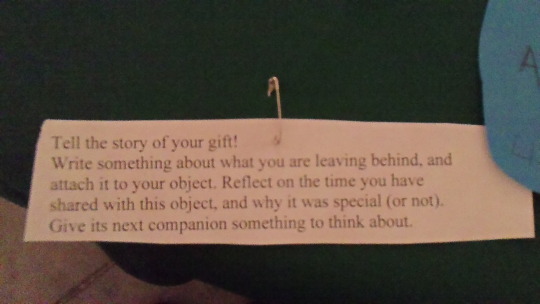
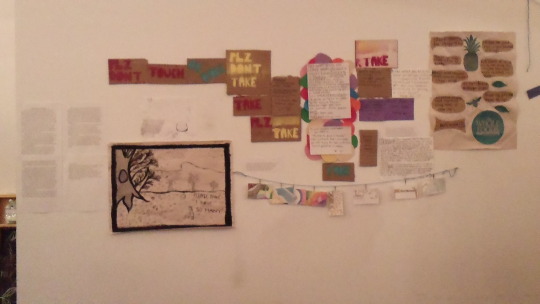
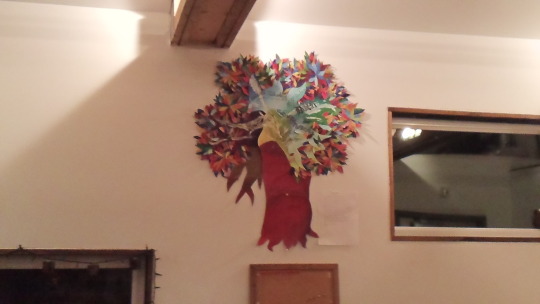
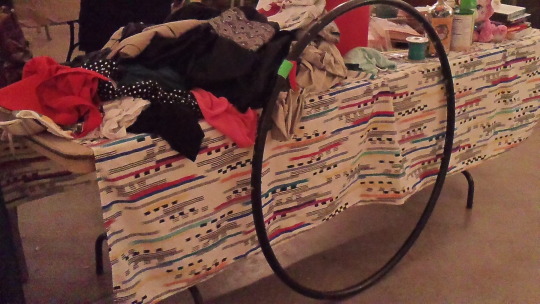
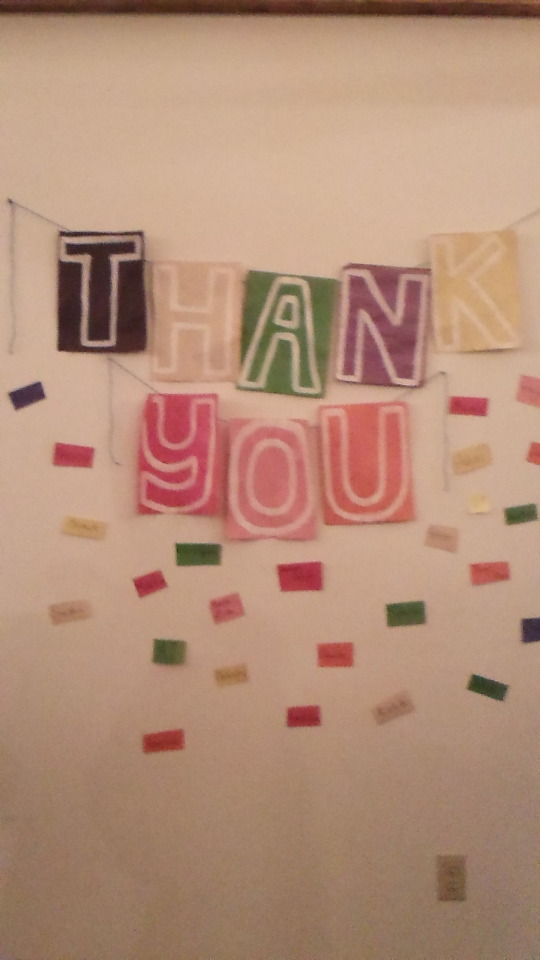
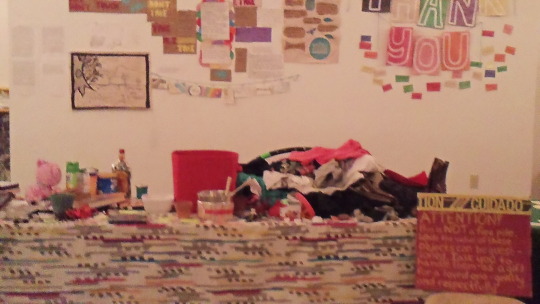

Final show pictures! Featuring my friend Elena’s inclusive education tree, and my mother contemplating next to the origami. (Fun fact: they are both named Elena!)
0 notes
Text
Reflection on my show
The final show happened last Friday, December 4th, 2015. I reflected on paper this time, but here I will post some highlights. -People came to help out of the blue. And I needed this dearly. Before the show began I needed the hands to move the couches in the space, move all my art, and set everything up. The unexpected task ended up being having to put tape on everything since the walls were too thick for thumb tacks. And luckily I had 3 people making tape loops for me. I still cannot believe that they showed up! All week I was looking for helpers, and it seemed like I was going to end up doing the whole thing myself. I am so thankful this was not true. -Perhaps this is the air of any final art show, but I got so many congratulations and appreciations for my project. This was really moving. I want to note what one of my attendants said - he said my writing piece made him think about the global economy, and my table made it come to life. There were at least 6 languages among the stuff - be it in instructions for an electronic appliance or on the lid of a tea kettle. That is truly beautiful, and something to think about. Among one of my paranoid thoughts, I thought about the contradictory nature of the exchange table and the food table which inherently embodied injustice and pollution. Who was going to bring this up and catch me? The person turned out to be my brother. At least it stayed in the family! And at least the food was eaten, and what was left I gave to my friend who hosted me all week. The gift returned. -I rain into one of my shows attendants a few days after the show, and found that my signage could have been more clear. While there were big invitations/instructions right next to the table, I put up all the signs asking people to not take things on the wall behind it. And this person (who’s name I forgot! Sorry if you are reading this!) thought that those were the real instructions, and I was conducting a psychological experiment to see who would take things and who would not. I guess I unwittingly did just that. Next time I need to make a sign saying which signs are true and which ones are not. -While the origami was lovely, them being in a nook limited the amount of people who could look at them at one time. This was unfortunate. -The show was scheduled from 6-10, but it began slowing down by 8. The wine and beer were drunk in less than an hour! Lots of people came, and I was especially proud to see those who I did not know or talk to. In the end, only a few people stayed, but the ones who stayed spent a while just hanging out and talking. I like that my shows give this kind of experience. Perhaps they will not gather a huge crowd, but will attract a devoted few. -My outfit consisted of gifts as well (sadly there will be no picture as I forgot to do a final show pose). The pants and socks were handed down from my mother. The boxers belonged to my partner. And the shirt was a gift from my friend Amelia - a few years ago when we were walking from class I saw she had no winter coat, and I gave her the one I was wearing, an old one. Next week she brought me a shirt custom-made for her as a gift. In the two years since, only one event felt appropriate for the shirt - the day I became an American citizen. The show was the second one. I hope to have more events that are worthy of this shirt.
0 notes
Text
How to make your own socially engaged art (SEA) project
First things first, as much as I desire to be helpful and informative, SEA like all art will be born from your own passions, ideas, and commitments. Pay attention to what I write, but take it with a grain of salt. Some information may be useful and inspiring, and some may not - ignore that part, or come back to it later and see if it is really true.
Research
What do you know about SEA? Perhaps you know a lot, or maybe you are just figuring it out. Browse - resources/artists, my own take on SEA as an art form. Research is important. Think of yourself as a scientist - before a scientist begins any project, they have to do research in order to find out if someone had done the same project before. This not only saves them the embarrassment of doing the same thing over again, it lets them build on what has already been done. Research does not just mean reading or watching a video. Research can be going out and experiencing whatever it is you want to learn about. Once learning about the basic ideas behind SEA, I see SEA everywhere. The same may happen to you... If you are on a college campus, you will most likely get an opportunity to be part of or witness a SEA project. Going to any art event or space may teach you something, even if it is not meant to be "socially engaged". When going into a traditional gallery, ask yourself what social engagement does appear in the space, and what opportunities there are to make it more socially engaged. If going with a friend, think about your experience of going to the museum together, and the influence it has on how you view the art. Either way, the methods and aesthetics of the artists you witness can always be an inspiration for your own projects. As SEA is fundamentally interdisciplinary, working in mediums you are not used to can always be helpful. Keep in mind that actually doing the project you decide to do counts as research, and the mistakes you make and enlightenment you receive will be some of the greatest lessons in social practice. Getting ready to act
There are many ways to begin a SEA project, and this depends on your time, resources, and community. If you are making art for a class or part of an arts community, you have a lot of advantages! But everything around you can be a resource. Take stock of these. Take time to answer the questions below. Give as many answers as you can - the idea is to see how much you can do with what you have.
What issues/ideas do you want to explore? What are you passionate about in this world? These can be local or global. (ex. waste, food justice, immigration, sexual education, etc., etc.)
Who do you want to work with? (your friends, your family, strangers, specific groups/communities, youth, etc., etc.)
Will these people be co-creators/collaborators, participants, audience members (all 3)?
What are your methods and mediums? (ex. research, visual art, performance, conversation, video, audio...)
What skills do you have? These do not have to be just art skills. Being good at cooking and cleaning is always a valuable asset (and the list goes on).
What resources do you have access to? Tangible/Intangible? (ex. the library, excess objects you may have, etc.)
What spaces do you have access to? Can these spaces be sites for your project? (ex. someone's kitchen, a classroom, a public park, etc.)
Will this project be a single or recurring event? (Or is that to be determined?)
Who will help you? Not just collaborate with you, but who will help you run errands, possibly give you rides, give you feedback, etc.?
Do you need extra resources? How will you get them? Maybe there are things you can get for free from work ;). If you are a student you may apply for a grant. Gofundme, Indiegogo, Kickstarter, etc. are websites through which you can receive funding for a project. Yard sales and bake sales are possibilities, as is cooking a fancy meal and asking each attendant to pitch in $5. What are some creative ways of raising money?
Keep your answers somewhere you can access later. This can be useful for a while. Perhaps you already know what you want to do, and how you will begin. That's great. If you do not, brainstorm 10 SEA projects you could do, with your answers to this exercise in mind. Now brainstorm 10 more. And 10 more if you really want a challenge. What comes up? Are they similar? Different? What do you not want to do, now that you have written it down? What do you feel excited about?
At some point, you will have to make a final decision on what to do. This, again, will be determined by your circumstances. If you start something and it does not seem like it is working - the community you want to engage is not responding well, you do not have enough resources, the project is not shaping into what you wanted - this may be a nudge for you to try something in a new direction. If needing extra inspiration/a more concrete exercise, try this one in observing a space.
Doing the project When you start doing, unexpected things may happen. This is normal. Social practice works with people, and working with people will always be messy. Accept this as part of the project. Let your work change with how people are responding to it. This does not mean giving up your vision, but it does mean looking at different ways of doing things. Accept the messy parts of everyday as blessings and valuable learning experiences in social practice projects. Document and reflect on your work. Documentation may seem dull (it often is to me), but even a few pictures on a camera let you travel back to the past, and recall certain things. To document you can also use writing, drawing, video, and audio (perhaps you know other techniques that I do not). Documenting allows you to share your experiences with a larger audience. You may not find it significant while you are doing it, but one day someone will ask what you did, and pictures/video/etc. will tell a great story. Reflection is one of the keys to learning. And this is not just reflecting after coming to an end of a few months' worth of work. Reflecting should be done often - try doing it once a week, or after any milestone in your project (new iteration, etc.) The more you reflect and build on your reflections, the more you are able to gather from your experiences. Some guiding reflection questions: What have I learned, why, and when? What difference has the learning/doing made in my intellectual, personal, and ethical development? In what ways is what I have done/learned valuable to have been done/learned at all? What worked/what did not work? What can I do to improve for next time? What are some outrageous new ideas I can implement? (first 3 questions taken/adapted from John Zubizarreta, The Learning Portfolio) Take time to reflect - 10-15 minutes at least. Reflection can be done either through writing or through talking it out (and recording the audio). It cannot just be done in your head. Our thoughts move quickly in there, and actually speaking or writing it down slows your thought process and makes valuable insights come to the surface. Find a way to show your appreciation for your collaborators/participants/helpers. Food is always a good idea. When you are done
When does a project end? Sometimes it is decided that it is only a one-time event, or a single piece of media you are making. Sometimes you stop because you do not wish to work with your partners/collaborators any more. There are many reasons as to why a project will end. Questions: Would you do it again? Under which circumstances? How would you change what you did? What were tasks you found yourself doing that you did not know you would do/need to do? (for example, the amount of e-mails I have sent about reserving spaces, buying disposable plates/cups for the opening, etc. were unexpected but necessary to make the project come to life) Is there something new and exciting you want to do now? I find myself going into fantasies of what I could be doing while in the middle of a project - perhaps you have these fantasies as well, and when you finish it is a good time to see which of these fantasies can come to fruition. However, before starting something new you will want to gather your documentation, reflections, and any materials left over in one space (or a few designated spaces). This activity can be reflective in itself.
0 notes
Text
master list of resources / artists in socially engaged art!
Artists/Projects/General Resources Education for Socially Engaged Art: A Materials and Techniques Handbook by Pablo Helguera (exactly as it says - outlines the basic tactics of SEA, problems you may face, etc.) excerpts on Helguera’s blog Living as Form: Socially Engaged Art from 1991-2011 by Nato Thompson (SEA history/theory essays by Nato Thompson, Claire Bishop, Maria Lind, Teddy Cruz, Carol Becker, Brian Holmes, and Shannon Jackson, as well as collection of 100+ SEA projects) The Social Turn: Collaboration and its Discontents by Claire Bishop http://www.sociallyengagedartjournal.org/ http://museumarteutil.net/ (the archive contains many socially engaged art projects) http://creativetime.org/ http://www.pbs.org/art21/ http://www.prole.info/ http://beautifultrouble.org/ http://openengagement.info/ http://www.socialpracticequeens.org/ (Queens Museum) Mel Chin Ai Weiwei - Never Sorry Marina Abramovic - institute - The Artist is Present Tania Bruguera - Immigrant Movement International - On Art 21 Rick Lowe - Project Row Houses Suzanne Lacy Mierle Laderman Ukeles - Maintenance art Manifesto 1969! Molly Crabapple - articles on Vice Amanda Palmer - the Art of Asking Fallen Fruit Collective Sut Jhally / Media Education Foundation /Killing Us Softly - Jean Kilbourne Taryn Simon - MOMA exhibition - Josh Greene Little Free Library Human Library Project Interference Archive Susan O’Malley (obituary) Occupation of Greenham Commons Solvognen - The Santa Claus Army Susan Jahoda kara lynch - invisible :: meet me in okemah :: saved -La Linea Andrea Dezso - Lessons from my mother The Young Turks - YouTube Voina Pussy Riot - in English Alina and Jeff Bliumis Sources tagged on this blog: http://sorok-a.tumblr.com/tagged/sea%20resource
2 notes
·
View notes
Quote
When my mind turned in on itself, I drew anyway, learning that art can’t save you from pain, but the discipline of hard work can drag you through it.
Molly Crabapple Drawing Blood (via tziganeheart)
96 notes
·
View notes
Text
Observation exercise
Exercise: If you have ample time to experiment and explore, try this task: observe a space you are interested in. This means experiencing the space for as much of a span of 24 hours as you can. Start with 2-4 hours in the space. Write down what you see, make sketches about the environment, just look around. Use the methods you are comfortable with to observe. You can switch from sitting in one place to walking around. After you feel like you have seen everything you have to see, try seeing more. What did you not find important? Write that down, too. If working in a group, you can divide the task of observing the space between group members, asking each one to observe it at a different time of day. If working alone, come back the next day at a different hour and see what has changed. After you collect this data, see what stands out. What are some frequent actions of the people there? What are important objects in the space? Is it a transitional space? Is it a space where people stay for a long time? With these questions in mind, plan an intervention - what are ways to engage people in this space? Is there a recurring problem in the space you want to confront? Reflect on this experience - what worked, and what did not? Put in a second intervention. Do this a few times. See what you have learned. Perhaps you have become attached to this space. Perhaps you want to see the intervention you designed somewhere else. (taken from Andrea Dezso and kara lynch/personal experiences of working in their classes)
0 notes
Text
What is socially engaged art (SEA)?
Socially engaged art (SEA) is an art practice that emphasizes participation and interaction. While it exists in traditional art disciplines, it can involve methods such as research, physical labor, etc. SEA encompasses many practices - participatory art, social practice, community art, activism, relational aesthetics, kontextkunst, new genre public art, connective aesthetics, and dialogic art. It may be used to describe anything ranging from the mass protests in Egypt's Tahrir Square in 2011, to election night celebrations in Harlem in 2008, to Complaints Choirs, literally organized choirs that sing their complaints, from most minute to ones felt on a global scale. The desire for social engagement can be traced back to art movements around the world including Russian Constructivism, Tropicalia in Brazil, and Theatre of the Oppressed. But today's SEA was not just influenced by art movements. The social movements of the 20th century - civil rights movement, AIDS activism, the women's movement and anti-Apartheid movement have all influenced what SEA has become today. As different SEA artists are influenced by specific communities, experiences, and disciplines, art under the same umbrella may look quite different. Participation is not synonymous with collectivism or inherently opposed to capitalism. While Western artists have used SEA as a tool for public engagement, artists in the USSR used participation to create private spaces for individual expression (Thompson, 2012). While SEA is an umbrella term for many practices, there are some criteria for what it is, and what it is not. SEA is anti-representational - it is not a painting of something, it is something. While SEA projects may rely on symbolic acts, they are the means for a communicative action (Helguera, 2011, p. 8). Many SEA projects happen outside of the gallery, or what we can call the "real" world. It must be noted that it is problematic to separate traditional art spaces from the "real" world as it implies that these spaces have no impact. However, we cannot deny that a separation between art and real exists. After all, “art” is the root of “artificial”. SEA stands in opposition to "spectacle", a term coined by Guy Debord in his film, The Society of the Spectacle. Spectacle is an integral feature of the modern world. It mediates social experience through images, and induces passivity of the audience. It exists both in capitalist and totalitarian societies (Thompson, 2012, p.36). Spectacle is propaganda, advertisement, popular film, music, and art. Spectacle replaces the tangible world by something inaccessible, yet remains more desirable than reality (Debord, "La société du spectacle"). Spectacle is meant to remove power from its viewers, so "engagement is [its] only antidote" (Thompson, 2012, p.71). The heightened zeal for SEA in the past two decades can be attested to the rise of neoliberalism, characterized by "[privileging of] free trade and open markets, resulting in maximizing the role of the private sector in determining priorities and deemphasizing the role of the public and the state's function in protecting and supporting them" (Thompson, 2012, p. 29). This system is inherently linked to injustice (Thompson, 2012, p. 75). Cruz notes that the income gap in 2008 United States is as great as it was in 1928, during the Great Depression. The Depression era was followed by greater taxation of the wealthy and a willingness to participate in public work (Thompson, 2012, p. 57). Today's economic crisis was followed instead by large cuts to public services, losses of homes and jobs, and the bailing out of its architects. Public engagement through the arts may be the natural solution to the current crisis, but it is important to remember that emphasis on participation may also pander to neoliberal ethics. Not all art that has a participatory aspect is necessarily resistant to the dominant culture. In fact, it can reinforce neoliberal ideology. Bishop notes that “today participation is used by business as a tool for improving efficiency and workforce morale; it is all-pervasive in the mass-media in the form of reality television; and it is a privileged medium for government funding agencies seeking to create the impression of social inclusion” (Roche & Bishop, 2006) . Thompson outlines two types of SEA projects – tactical and strategic. Tactical works are temporary, interventionist and discreet pieces quickly consumed and “digested by conditions of power” (Thompson, 2012, p. 31). Strategic works on the other hand are long-term investments based in local communities. Lind notes that short-term works may develop into long-term efforts (Thompson, 2012, p. 50). It is important for artists to understand the line between self-promotional works and works that are good for the community. Bishop creates another distinction between SEA projects. While some are meant to empower its participants, or others instead wish to further the alienation of its participants. While at first glance, SEA is linked to social justice and social work, this is not necessarily true. SEA is the product of tension and play of social and aesthetic commitments – neither can be privileged in its critique (Thompson, 2012, p. 38). Reducing it to social work means focusing critique on its ethics rather than its aesthetic. Focusing solely on the social aspect of SEA makes it vulnerable to corporate and state cooptation. We must trust that aesthetic also carries a positive social impact (Bishop, 2006). Art is not social work - it does not come with understood rules of engagement with its participants. In fact, the rules of engagement change depending on the project. Bishop suggests that the relationship between artist and participant in SEA is not solid and systematic. Rather, it is a fluid tension between artist and participant, likened to BDSM in its constant re-visiting and re-affirming of relationships (Thompson, 2012, p.41). It may be tempting to give up all power to participants, but an artist should not feel guilt over claiming some power. The label of art gives SEA freedom to perform works for social good alongside antagonizing social critiques. However, art, even SEA, is not enough to create lasting social change. At a point, artists must allow other institutions to step in while “[reasserting] art’s inventive forms of negation as valuable in their own right” (Thompson, 2012, p. 45). Sources used: Guy Debord, The Society of the Spectacle Claire Bishop, The Social Turn: Collaboration and its Discontents Pablo Helguera, Education for Socially Engaged Art: A Materials and Techniques Handbook Nato Thompson, Living as Form: Socially Engaged Art 1991-2011
#socially engaged art#sea#pablo helguera#nato thompson#claire bishop#guy debord#society of the spectacle#teddy cruz#neoliberalism#art#participatory art#relational aesthetics#dialogic art#performance art#social practice#community art#sea resource
1 note
·
View note
Link
an MFA project by Caroline Keniston involving food and social engagement.
1 note
·
View note
